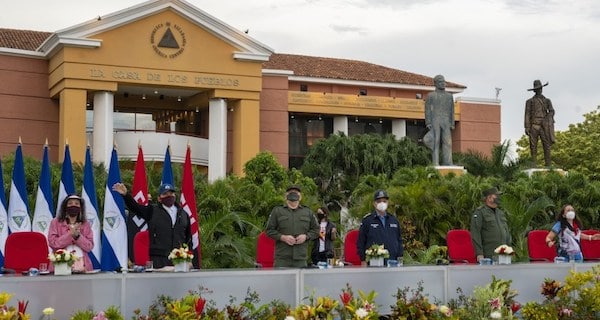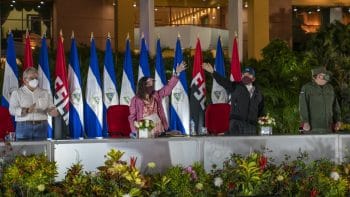Since the 1823 declaration of the Monroe Doctrine, the U.S. government has portrayed all of Latin America as its own imperial “backyard.” Among the most enticing prizes for U.S. political leaders and corporate oligarchs over the decades has been Nicaragua.
A North American colonialist and mercenary named William Walker declared himself the dictatorial president of Nicaragua in 1856, touching off a war across Central America that left thousands dead. In 1909, the U.S. military invaded Nicaragua and overthrew its progressive president, José Santos Zelaya, a nationalist who sought to reunify Central America in a federal republic, and who had canal plans of his own. This set the stage for decades of continuous U.S. military interventions, interference, and occupation of the country.
Nicaragua’s tragic historical trajectory changed on July 19, 1979, when a grassroots army of revolutionary socialists overthrew a brutal Washington-backed dictatorship ruled by General Anastasio Somoza Debayle, who was trained by the U.S. military, and whose family had ruled Nicaragua with an iron fist for decades.
The triumphant guerrilla army called itself the Sandinista National Liberation Front (Frente Sandinista de Liberación Nacional, or FSLN in Spanish). It drew its name and inspiration from the Nicaraguan revolutionary leader Augusto César Sandino, who waged war on the U.S. military occupiers during the 1920s and ’30s, driving them from the country before he was killed by General Somoza’s father, the patriarch of the family dictatorship.
While Sandino’s vision of a free, progressive, and anti-imperialist Nicaragua was not realized in his lifetime, the FSLN gave birth to it just four decades after his death.
And although it has faced no shortage of obstacles, sabotage, and violent conflict since then, the Sandinista Front still governs Nicaragua today, now through democratic elections.
This July 19, 2020, Nicaragua celebrated the 41st anniversary of the triumph of the Sandinista Revolution. It came at a turbulent moment for the country, two years after an extremely violent U.S.-backed coup attempt and in the middle of the global COVID-19 pandemic.
The Nicaraguan government cancelled all of the annual public events commemorating the revolution out of concern over the coronavirus crisis. Instead President Daniel Ortega, clad in a protective mask, spoke before a relatively small group of Sandinista Front officials and activists in a controlled environment, to prevent spread of the virus.
The Grayzone’s Ben Norton was the only foreign member of the press to attend Ortega’s speech in Plaza de la Revolución, in the heart of the capital Managua, where the president condemned “savage capitalism” and U.S. interference in his country’s affairs, trumpeted the gains of his nation’s free socialized health system, and said the failure of rich developed countries in the Global North to protect their own citizens during the pandemic was a “wake-up call” that a new global economic model is needed.
The Grayzone reported on these events from inside Nicaragua, to show how the Sandinista government has grappled with the issues–and how foreign corporate media coverage on the country is hopelessly biased, misleading, and in some cases even outright false.
At the 41st anniversary of Nicaragua's Sandinista Revolution, President Ortega said the failure of the US and Europe to protect their citizens in the Covid-19 pandemic is a "wake-up call" that "savage capitalism" has failed and a new economic model is needed.
By @BenjaminNorton pic.twitter.com/r4LWKH1EGE
— The Grayzone (@TheGrayzoneNews) July 21, 2020
The Sandinista Front’s fight against poverty, coronavirus, and imperialism
Since it ousted the Somoza dictatorship, the Sandinista Front has made many gains for Nicaragua’s citizens. Though it lost power in 1990, following a bloody U.S.-backed proxy war and suffocating economic blockade, the FSLN eventually won back the government through democratic elections in 2006.
Carlos Fonseca Terán, the international relations secretary for the Sandinista Front, stressed in an interview with The Grayzone the many achievements the FSLN has made since returning to power.
“Going from the fourth-most unequal country in Latin America, during the neoliberal era (1990-2006), we have become the fourth-least unequal,” Fonseca pointed out with pride.
In the past 13 years of Sandinista rule, overall poverty in Nicaragua has been reduced from 48.3 percent to 24.9 percent, and extreme poverty from 17.2 percent to 6.9 percent. Illiteracy has fallen from 35 percent to 3 percent.
Social spending in all areas has skyrocketed, and the FSLN government created an ambitious system of universal healthcare and education–something unheard of in Central America, one of the poorest regions in the world.
The Sandinista Front has placed special emphasis on women’s empowerment. Nicaragua has the fifth-highest gender-equality rating in the world, and the smallest gender gap in all of the Americas.
“Our socioeconomic and political model has its fundamental base in popular power,” Fonseca stressed.
The expression of that in politics is citizens’ power as an organized expression of popular influence on public affairs, the ‘protagonism’ of social movements in the mechanisms for decision-making, the participation of social movement leaders in institutional spaces of the state.
Since the COVID-19 pandemic hit South America in early 2020, it has devastated the economies of numerous countries in the region.
Nicaragua has been one of the least affected economically. The Sandinista government attributes this to an unorthodox strategy it adopted at the beginning of the outbreak.
Nicaragua never imposed a full quarantine and didn’t shut down the entire economy, instead taking a middle-of-the-road approach that balanced its people’s economic needs with public health concerns.
The FSLN government published an official document called the Libro Blanco (White Book), which outlined a strategy for bolstering Nicaragua’s already robust universal health system, implementing safety measures, and working with small businesses to ensure that the needs of Nicaraguans are met–with the acute understanding that roughly 40 percent of the population lives in the countryside and some 80 percent of urban residents work in the informal sector and live day-by-day, without a steady paycheck.
“In our country, due to the particularities of our customs of socialization of property and economic democratization of the society, there is not the same division between the economy and life,” Fonseca explained.
The guiding principle of our model of confronting the pandemic is combining the best possible level of social distancing with the best possible functioning of the economy for life.
This approach, which was also to an extent shared by Sweden, was for months subjected to harsh international criticism. But it is now the model being gradually adopted by most countries, as they try to restart their economies.
The Grayzone has previously reported on the disinformation campaign against Nicaragua over the coronavirus, and how the country’s right-wing opposition, which is flush with millions of dollars of funding from the U.S. government, has tried to weaponize fake news and misleading claims about the FSLN’s COVID-19 policy to spread fear and destabilize the country.
Fonseca Terán explained,
The response of the right-wing has been a combination of calls for paralyzing the country and celebrating the (U.S.) economic aggressions against Nicaragua, spreading fake news about a supposed medical collapse to discourage people from going to the hospitals, and creating an environment of fear to impede our actions against the pandemic.
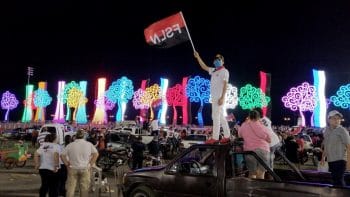
Sandinista supporters fill with Managua’s Plaza La Fe with their cars and protective equipment round midnight on the evening of July 18, 2020 (Photo credit: Ben Norton / The Grayzone)
International corporate media outlets have helped Nicaragua’s foreign-sponsored opposition groups to amplify this chaos with fake news campaigns and misleading reports. There have been numerous reports in top U.S. and British newspapers falsely claiming that the FSLN government has held demonstrations and public events during the coronavirus outbreak. This is categorically false, as was evident on what Sandinistas consider to be the most important day of the year: July 19.
Celebrating the 41st anniversary of the Sandinista Revolution
The 41st anniversary of the Sandinista Revolution could not have been more different from the celebration the year before.
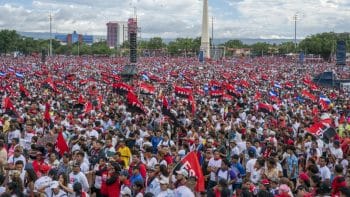
The 40th anniversary celebration of the Sandinista Revolution, in Managua’s Plaza La Fe in July 2019 (Photo credit: Ben Norton / The Grayzone)
In July 2019, The Grayzone’s Max Blumenthal and Ben Norton reported on the 40th anniversary. Hundreds of thousands of Nicaraguans from across the country flooded the capital, filling Managua’s Plaza La Fe to the brim, and stood for hours under the baking sun, brandishing leftist flags and clothes, eagerly devouring the revolutionary sermons of Sandinista leaders and foreign dignitaries.
By July 2020, the entire planet had ground to a halt by a coronavirus strain that left hundreds of thousands of people dead and unleashed a global economic crisis.
In response to the COVID-19 pandemic, in March, the Sandinista government cancelled all public events. This meant that not only was the enormous July 19 rally called off, but also other important national holidays marking victories in historic battles, the commemoration of the June 23 birthday of Sandinista Front founder Carlos Fonseca Amador, and even public funerals for revolutionary leaders Edén Pastora and Jacinto Suárez, who died during the crisis.
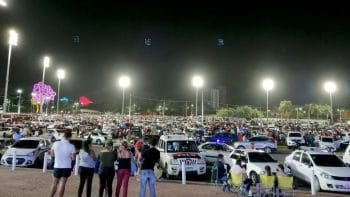
Sandinista supporters fill Managua’s Plaza La Fe with their cars and families on the evening of July 18, 2020 (Photo credit: Ben Norton / The Grayzone)
These cancellations, and the global health catastrophe, slightly dampened the spirits of Nicaraguans. But it didn’t stop grassroots Sandinistas from showing their love for the movement.
In lieu of its annual July 19 rally, the Nicaraguan government decided to hold a midnight TV broadcast of fireworks.
So thousands of Nicaraguans spontaneously flooded downtown Managua out of their dedication to the Sandinista Front.
Usually on the night of July 18, millions across Nicaragua hold huge community parties, called vigilias, in their barrios to commemorate the anniversary of the revolution at midnight.
In July 2019, The Grayzone reported from a vigilia in San Antonio, a working-class barrio in Managua, where thousands of largely young Sandinista supporters celebrated with a concert.
Here is video you will never see in mainstream corporate media: Thousands of Nicaraguans gathered in Managua's working-class barrio San Antonio tonight to celebrate the 40th anniversary of the Sandinista Revolution.
This is just one celebration among countless across the country pic.twitter.com/Xn13eryBKW
— Ben Norton (@BenjaminNorton) July 19, 2019
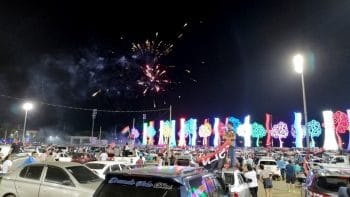
Fireworks in Managua, Nicaragua at midnight on July 19, 2020 (Photo credit: Ben Norton / The Grayzone)
But for the first time, in 2020, there were no vigilias. Instead, people organically filled Managua’s Plaza La Fe with their cars, families, and friends. Many wore protective masks as they waved their Sandinista flags and watched the fireworks.
This had not been planned beforehand; it truly happened at the grassroots. FSLN activists I spoke with made it clear that this event was not sponsored by the government, which was not encouraging people to come out and was following public health measures.
President Daniel Ortega delivers fiery speech condemning “savage capitalism”
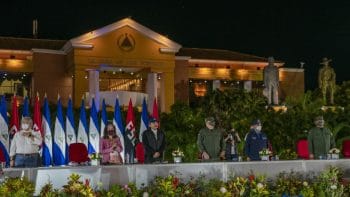 On the evening of July 19, the Nicaraguan government held a small gathering in Plaza de la Revolución, the site where the Sandinista guerrillas had declared victory 41 years before.
On the evening of July 19, the Nicaraguan government held a small gathering in Plaza de la Revolución, the site where the Sandinista guerrillas had declared victory 41 years before.
President Daniel Ortega delivered a lengthy speech addressing the COVID-19 pandemic and the global economic crisis, calling it an indictment of foreign neoliberal for-profit health systems.
He sat with top government officials, all of whom were wearing medical masks, including Vice President Rosario Murillo, National Assembly President Gustavo Porras, and the directors of the health ministry, finance and public credit ministry, military, and police.
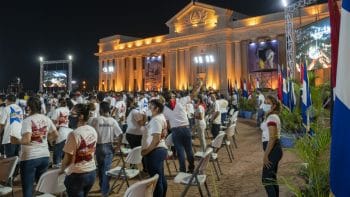 Hundreds of Sandinista Youth activists sat in the audience. Everyone wore a mask, with chairs spaced out to maintain social distancing.
Hundreds of Sandinista Youth activists sat in the audience. Everyone wore a mask, with chairs spaced out to maintain social distancing.
The Sandinista Youth (Juventud Sandinista) are the lifeblood of the revolutionary movement. They are the young activists, almost all of whom are volunteers, who work at the grassroots, provide services to everyday Nicaraguans, and organize their neighborhoods.
In his speech, President Ortega condemned the exploitative “economic model that has been installed in the world” that puts profit over people. He pointed out that the pandemic “does not touch the pockets of large capital,” that huge corporations are doing fine, while poor and working people are suffering and dying.
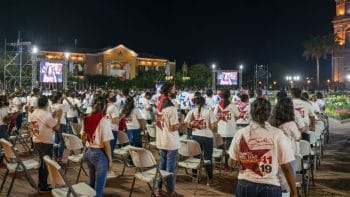 In a gripping moment, Ortega called the COVID-19 pandemic an international wake-up call, declaring:
In a gripping moment, Ortega called the COVID-19 pandemic an international wake-up call, declaring:
The worst epidemic is what causes hunger, and that is the epidemic of savage capitalism, which was put into place across the world, until this epidemic (of COVID) arrived, and shook it up. It has shaken up savage capitalism and is telling them, ‘That is not the path!’ It is shouting to them that that is not the path, and that if they want to protect their peoples–because with all of their capacities, with all of their riches, they have not been able to protect their citizens.
Because their hospitals have been overflowing; because they did not have the medical equipment to deal with the emergencies in the developed countries, in Europe, and in the United States of America, that great power that spends billions and billions of dollars on war, on death. How many North Americans–and how sorry we are for this–have died due to a lack of medical attention in the United States?
That is what lays bare the failure of that model. And that is the wake-up call that is being sent by God, with the force of nature, to savage capitalism: That the path must be changed, the path must be changed, and that they learn to practice a form of commerce, of social development, of economic development, of financial development, that is just and based on solidarity, that will bring peace and tranquility to all of the inhabitants of our planet.
Nicaragua’s free universal health system
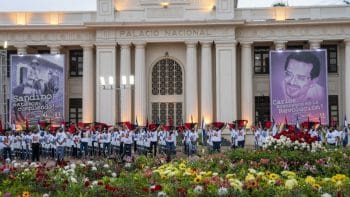
Sandinista Youth activists hold up their FSLN bandanas in front of Nicaragua’s National Palace in Managua, on the 41st anniversary of the revolution (Photo credit: Ben Norton / The Grayzone)
The one theme that President Daniel Ortega stressed above all others in his speech was how important it is for countries to create universal, not-for-profit health systems. He emphasized that the Sandinista government has invested vast resources creating a free, socialized health program that serves “the poor, the humble, the workers, the people.”
In the 13 years since the Sandinista Front returned to power in Nicaragua in 2007 through democratic elections, Ortega boasted, the FSLN government has built 19 new hospitals, 18 regional health centers, 452 neighborhood health offices, and 128 maternal homes, where pregnant women with few resources or from rural areas can go to live and/or receive free medical attention.
An additional seven new hospitals are currently in construction as well. And Nicaragua has established 80 mobile health clinics which travel to different working-class barrios to help residents.
Since the Sandinista Front returned to power in 2007, the number of health workers in Nicaragua has increased from 22,000 to 36,983 (a growth of 168 percent); the number of doctors, from 2,715 to 6,182 (a 228 percent increase); and the number of nurses, from 6,384 to 11,050 (173 percent higher).
The neoliberal governments that ruled Nicaragua from 1990 to 2007 had systematically privatized and underfunded the country’s health services. This created a grossly unequal system in which rich Nicaraguans received superior medical attention, while poor workers often died from basic preventable ailments.
The Sandinista government’s establishment of free socialized healthcare, along with universal education, has been one of the keys to its popularity, helping to maintain a core working-class base of people who had never been helped by the government before.
The Nicaraguan government goes out of the way to make sure that its citizens know their medical services are free. When I visited the cozy town of Jinotega, nestled in the mountains north of the capital, I walked by the community’s main hospital, which has a message printed on the side in all capital letters and conspicuous blue font:
In this hospital all of the health services are totally free. If they give you a bill, immediately report it.
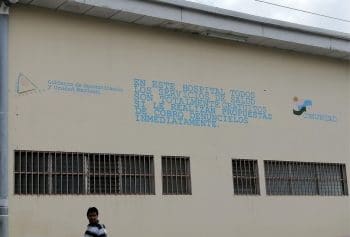
A message printed on a hospital in Jinotega, Nicaragua stressing that all medical services are free, taken in May 2020 (Photo credit: Ben Norton / The Grayzone)
“What does a family do if there is no healthcare? They lose the ability to work; they keep continuously getting sick,” President Ortega proclaimed in his anniversary speech, explaining the Sandinista Front’s outlook.
What do children and the youth do without healthcare? They lose their ability to go to school; they get sick. And what do workers, construction workers, fishers, shopkeepers do?
“What do the farmers do without healthcare? Well, productive activity would collapse, and many people in our country would go hungry and die, as billions of people across the planet do,” the FSLN leader added.
Ortega went out of his way to thank farmers, construction workers, teachers, and all workers, praising them for keeping society running. He reiterated the Sandinista Front’s commitment to collaborating closely with and helping workers, especially in the food sector.
Ortega also thanked the brigade of Cuban doctors who arrived in Nicaragua to assist in the fight against the pandemic. Cuba has sent similar medical teams to more than 30 countries, including industrialized nations like Italy.
Daniel Ortega appeals for peace–and calls out U.S. role in violence and coups
After the importance of universal socialized healthcare, the other theme that Daniel Ortega stressed the most in his speech was how fundamental peace must be for the country to advance.
“Our commitment is to peace, unity, and stability for the Nicaraguan people,” the president said. All of Nicaragua’s substantial social “programs can only be carried out when there is peace. Because if there is not peace, it is impossible to develop these programs.”
“Because that is what has happened on other occasions,” Ortega added, indirectly referencing the 2018 coup attempt and the US-backed Contra terror war in the 1980s.
They destroy ambulances; they kill drivers; they kill health workers and education workers.
“We lived through this in the years after the victory of the revolution,” Ortega continued.
They destroyed equipment that was being used to build roads in the mountains. They destroyed hospitals and health centers. They killed teachers; they killed doctors. There were thousands of deaths! There were 50,000 victims of that terrible war that was imposed on us by the U.S. government.
Despite the 1990 peace agreement that ended the U.S.-backed war on paper, Ortega noted,
There remained remnants of that war; there remained stay-behinds who continued committing crimes against working families, against families that didn’t want to give them what they demanded, and that killed Sandinista leaders, and that killed judges, and that killed entire families. And they were fed, funded, and armed.
Ortega said these gangs that had their origins in the U.S.-created Contra army have killed hundreds of people since 1990, and were involved in drug trafficking linked to Colombia. “But the so-called ‘human rights’ organizations run by the (US) empire, that are funded by the empire,” have blamed these deaths on the police and the military, Ortega added.
As his stem-winding address drew to a close, the Nicaraguan president–who is known to his supporters as El Comandante (the Commander), given his military leadership in the armed struggle in the 1970s–stood up and railed against U.S. imperialism.
“Look at the hardships that are happening in Europe, powerful countries, the hardships that are going on in the United States, where they don’t even think about spending billions of dollars to try to put out the fire, but they weren’t able to,” Ortega said.
So imagine what “it means to manage an economy like ours, so small, so fragile, attacked by the empire,” he continued. “Yes, attacked by the empire! That is, something totally brutal. An empire as powerful as that, torturing a country like Nicaragua, trying to hurt the Nicaraguan people, trying to demoralize the Nicaraguan people, trying to frighten the Nicaraguan people.”
“But the people have shown, in the most difficult circumstances, that the people are not cowards, that this is a brave people,” the president added.
Ortega boasted that September 2021 will be the 200th anniversary of Central American independence from Spanish colonialism, and that Nicaragua has a long history of resisting foreign conquest.
 Media smears and double standards
Media smears and double standards
At 74 years old, Daniel Ortega is certainly not in the greatest of health, although he is still younger than 77-year-old Joe Biden, and the same age as Donald Trump.
This March and April, international corporate media outlets spent weeks in falsely implying that the Nicaraguan president was dead.
The fake news blitz was emblematic of the overall atmosphere of chaotic disinformation that has targeted Nicaragua and its leftist government during the coronavirus pandemic.
In a previous dispatch from Nicaragua, The Grayzone explained how the Sandinista government has been trapped in a “damned if you do, and damned if you don’t” situation with COVID-19, where it is attacked no matter what it does.
The response to the 41st anniversary celebration by the right-wing opposition and its corporate media mouthpiece is yet another prime example of the catch-22 situation.
The same conservative media outlets that have relentlessly criticized the Sandinista government for not imposing a total quarantine suddenly shifted course and lambasted the FSLN for hosting the small, socially-distanced private event in Plaza La Revolución instead of holding its massive annual rally.
“Rosario Murillo turned July 19 into a private event that not all Sandinistas were invited to,” complained La Prensa, a Nicaraguan opposition outlet that has historically been supported by the U.S. government’s National Endowment for Democracy (NED), a CIA cutout that bankrolls Nicaragua’s opposition.
La Prensa gloated that Plaza La Fe, in the center of Managua, was empty on the morning of July 19, when it is normally jam-packed with hundreds of thousands of Sandinistas. The right-wing media outlet used a photo of the empty plaza to imply that the FSLN had lost its popular support.
This is the same opposition publication that has printed hundreds of articles attacking the Sandinistas for not cracking down enough over the coronavirus, outlandishly claiming that the democratically elected government, which it demonizes as a “regime,” is supposedly “applying a ‘strategy’ that not only permits the propagation of the virus, but which promotes it.”
This shameless propaganda shows how the Nicaraguan opposition tries to have its cake and eat it too, using dishonest tactics to attack the government no matter what it does.
The hypocrisy of Nicaragua’s U.S.-backed right-wing political forces is mind-boggling. Because while they have endlessly reiterated these critiques of the government, and with the help of the international media lied about its Covid response, claiming they are in danger, opposition leaders simultaneously go partying at clubs and beaches.
At 1 am on July 19, as Sandinistas celebrated in humble working-class barrios, the bars in a rich neighborhood in the capital were filled to the brim with wealthy young opposition supporters dancing and downing expensive spirits.
Anti-Sandinista elements flooded Managua’s hip Zona Hippos, home to some of the capital’s most popular clubs and bars, where food and drinks are pricey and designer clothes are ubiquitous.
Usually on the night of July 18, millions across Nicaragua hold big community parties in their barrios celebrating the anniversary of the Sandinista Revolution at midnight
But for the first time people spontaneously filled Managua's Plaza La Fe with their cars, families, friends pic.twitter.com/VLupfHbQYd
— Ben Norton (@BenjaminNorton) July 19, 2020
Just like the elite right-wing oligarchs living luxurious lives in Venezuela, the U.S.-backed opposition in Nicaragua consists of the richest people in society. They belly-ache about the government because it prioritizes poor and working people and shell out U.S. dollars at nighclubs every weekend.
Latin America is on the front lines of a global class struggle. In Nicaragua, Venezuela, and Cuba, it is clear that the governments are committed to serving workers. That much is evident in how devoted ordinary people are to defending them. And the U.S. empire is hellbent restoring the lost privileges of its loyal oligarchic allies.
But the popular leftist movements in the countries dubbed by Washington hardliners as the “Troika of Tyranny” have demonstrated their willingness to endure brutal sanctions and destabilization campaigns to preserve their hard-earned freedom.
“The interventionism of U.S. imperialism in our country through its history has as its principal expression five armed interventions, three of which were direct, four of which our people have defeated,” Carlos Fonseca Terán, the FSLN international relations secretary, told The Grayzone. “Today, that interventionism continues and consists of economic and political aggressions.”
“But once again, the people of Nicaragua are successfully confronting the aggressions of imperialism,” Fonseca added optimistically,
and will continue moving forward in this revolutionary process, advancing from victory to victory.

